You can make pure coconut oil soap, using coconut oil, lye and water. You can make it special by adding lavender essential oil and a violet ultramarine. A homemade wonderful coconut oil soap recipe with lavender scent and color – great for soap making beginners.
Table of Contents
- Coconut Oil Soap
- How To Make Pure Coconut Oil Soap
- This Recipe Traces Quickly – Be Careful
- Gel Phase
- Find Where to Buy Coconut Oil Soap
- How To Use This Soap
- Related Posts
- Watch This Video About Safety
- Cold Process Soap Making Tutorial Video
- Cold Process Soap Making Lessons
Coconut Oil Soap
Coconut always reminds me of warm weather, tropical islands, fruits and scents. Therefore in my imaginary, taking a bath or shower with a coconut oil soap it’s almost a tropical thing. And while unrefined coconut oil does smell like coconut, its resulting soap does not: the saponification is a realitely strong chemical reaction that destroys scents and even colors. If you wish for a coconut oil soap smelling like coconut, you do have to use a coconut fragrance.
For soapmakers, coconut oil soap has a different meaning. It means high cleansing and great foam – the best created by soaping oils. Hardly any soap recipe that calls for a oil mixture doesn’t have coconut oil, because of its wonderful soap properties.
For me, it started to mean the same thing: moisturizing, cleansing, foamy and pure white soap. And while it doesn’t smell like coconut, the soap natural scent is subtle but pleasant.
How To Make Pure Coconut Oil Soap
When starting to read about soapmaking, pretty quickly you will learn about two long-standing rules:
1 – Do not use more than 30% coconut oil in a recipe – it will leave your skin very “dry” (check for coconut oil in Oil Properties for Soap Making).
2 – Do not use a percentage of “superfat” (extra oils) greater than 8% to 10% or the soap will become too soft, too oily, will make little foam and is susceptible to get rancid fast and create DOS – Dreaded Orange Spots.
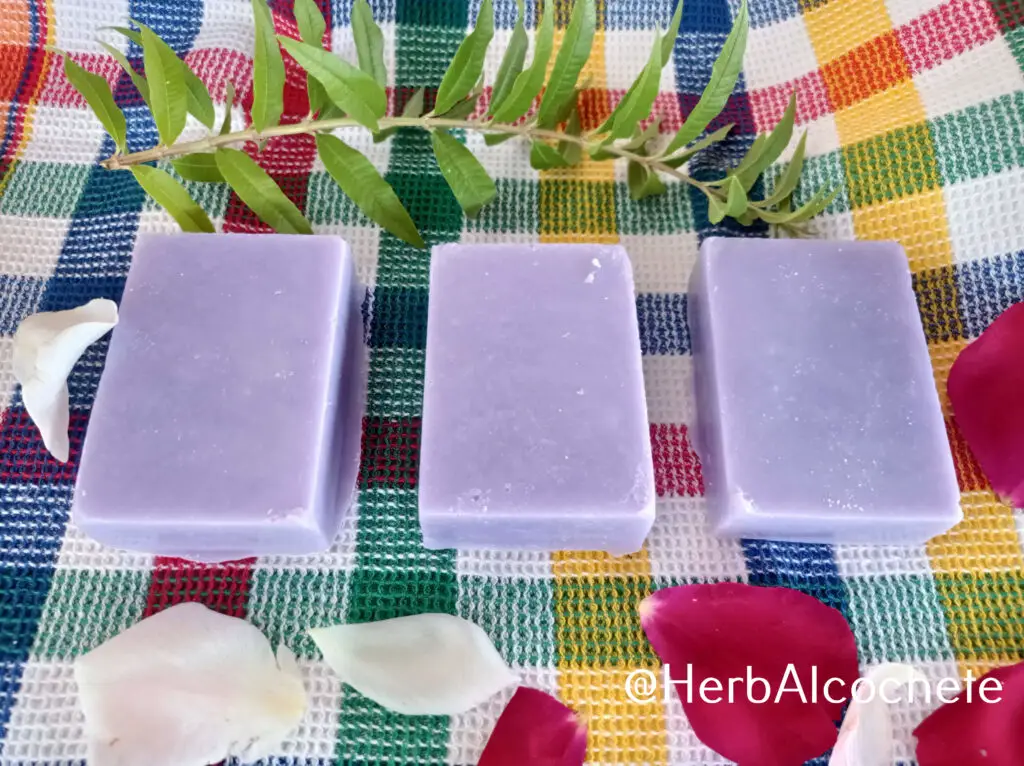
However, that’s exactly how you make a pure coconut oil soap. Coconut oil cleansing, hardness and conditioning properties allied with 20% superfat combine to counteract the negative effects of using a high percentage of coconut oil – which dries the skin – and a high percentage of “superfat” – which makes the soap too soft and “oily” -, resulting in a spectacular soap.
The explanation is that coconut oil does not dry the skin, it is just a strong cleansing agent. Cleans the skin so deeply that it completely removes the fatty layer from the skin, leaving it with a dry feeling. But coconut oil alone is moisturizing for the skin. With an extra 20% of coconut oil the dryness effect disappears, resulting in a smooth and skin-friendly soap.
As for becoming rancid due to the high amount of extra oil, coconut oil is very stable and long lasting. On the other hand, coconut oil always produces a very abundant foam, so the negative effects of a high “superfat” are not applicable in this case.
This Recipe Traces Quickly – Be Careful
While making an Olive Oil Soap Recipe you will notice that it will take around 10-15 minutes to reach trace. After adding the after-trace ingredients like essential oils and the anti-oxidant, the soap batter remains liquid and it’s easy to pour on molds.
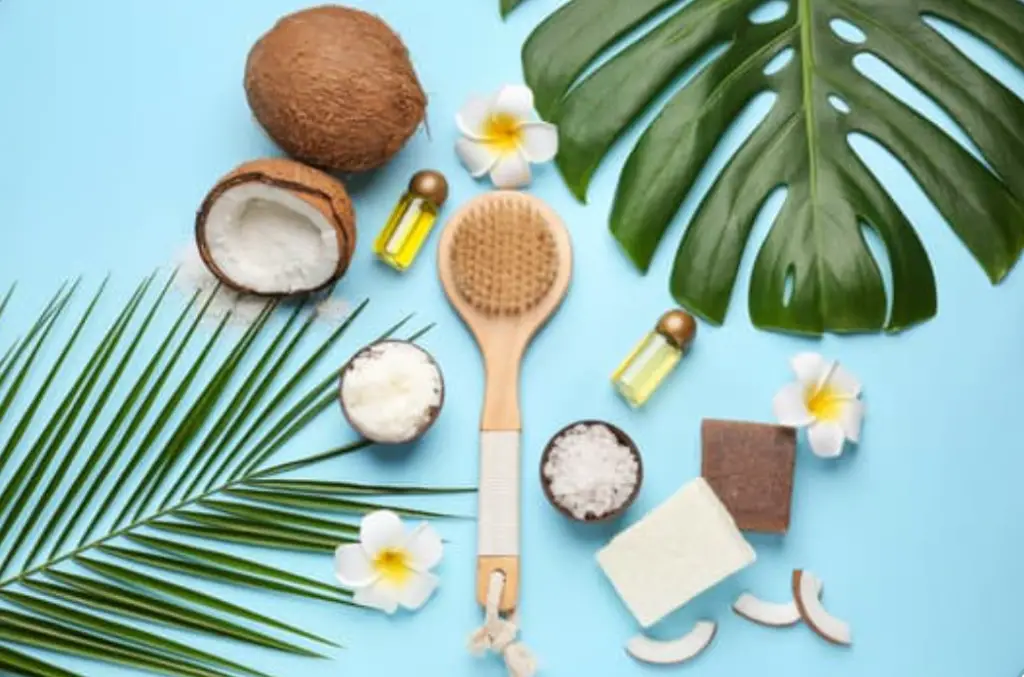
Be careful with this coconut oil soap recipe, as it won’t quite behave that way, simply because coconut oil is a hard oil, and the soap made with hard oils has a tendency to trace quickly. This means that the soap batter will start hardening very quickly, sometimes instantly – it’s called “seizing” or “soap acceleration“.
Bear in mind that your soap will always be good, whether you have trace acceleration/seizing, or not. The only problem will be the shape and looks of the soap bar.
I have adjusted the temperature to 35ºC – 95ºF (I usually use 38ºC to 40ºC – 100ºF to 104ºF to ) and a low lye concentration (more water) to slow down trace. Still, and especially at the moment of adding essential oils – they also speed up trace in general – be ready to pour your soap into the molds.
Have fun at home doing your coconut oil soap!
Gel Phase
If you look carefully at the photo below, you will see that the soap has a sort of “glossy” surface, while it looks slightly translucent and darker in the center. That is because, for the first time, I had soap going through gel phase in my rectangular soap molds, without the need to insulate the mold.
Gel phase is a part of saponification when soap gets really hot – up to 82ºC – 180ºF. When it happens, your soap will have a sort of gelatinous/glossy look, and deeper, more vibrant colors. I wasn’t planning to make it happen, but it was hot in that day and room temperature was around 30ºC – 86ºF, which obviously helped with gel phase.
To have soap going through gel phase or not is a matter of aesthetics and personal taste.
For example, if I am making soap in a bulk bar (a box soap mold) I want to force gel phase, because the soap will definitely gel in the middle, and if I don’t properly insulate the whole soap, I will have a “dark circle” or “stain” in the middle of the soap bars.
If I want my rectangular bars to have an opaque, pastel color, I use low temperatures and I don’t insulate the soap mold. I would just like to add that gel phase doesn’t affect the quality of the soap, just its looks and color.
If you want to know more about gel phase, how to force it and how to avoid it, check out also this article.

Find Where to Buy Coconut Oil Soap
If you’re not yet ready to try to make this recipe at home, but you still wish to enjoy natural soaps, you can find handmade coconut soap in the following links:
- 100% Coconut Oil Soap Bar (Etsy)
- Lavender Coconut Oil Soap Bar (Etsy)
- Gardner Coconut Oil Soap Bar (Etsy)
- Coconut Palmarosa Bar (Etsy)
- Other Soaps – Top 20 Handmade Soap and Shampoo Bars from Apple Valley
How To Use This Soap
In the shower or bath, wet your hands and rub your soap in them to create a lather. Wash your hands first, then repeat the process and apply soap to your whole body using the soap directly and your hands. You may also wash your face with it. Rinse hands and body abundantly. Also wash your soap from lather before placing it in your soap dish or bag saver.
Washcloths and sponges should be avoided. Avoid washing your intimate zone and your hair, soap pH in not adequate for those parts of your body. Avoid eye contact with soap to prevent stinging. Make a patch test before using your soap. Stop using your soap if you feel any immediate adverse reaction in your skin (red skin, rashes, itching).
To take best advantage of your handmade soap (made by yourself or store-bougth), read How Do You Use Handmade Soap?
Related Posts
Ingredients and Recipes
- Vegetable oils: Oil Properties For Soap Making
- Essential oils: Best Essential Oils for Soap Making
- Colorants: How To Color Your Soap With Kitchen Ingredients
- Beginner Recipes: Soap Recipes for Beginners
- Cold Process Soap Recipes: Free Cold Process Soap Recipes
Soap Making Techniques and Troubleshooting
- Cold Process Tutorial Guide: Learn To Make Cold Process Soap?
- Soap Making Methods: How To Make Soap At Home
- Soap Making Trace: Know Everything About Trace in Soap Making
- Soap Acceleration: Causes, How To Avoid It Or How To Fix It
- Soda Ash In Soap: What It Is, How to Remove It
Watch This Video About Safety
Cold Process Soap Making Tutorial Video
Cold Process Soap Making Lessons
The tutorials in this blog are a great – and free! – help to start with cold process soap making. Practice is the next step to harness the art of making soaps at home. However, I understand if you prefer to have some formal lessons, where you will feel more supported with the steps. Feel free to join these courses at Udemy.
Equipment
Ingredients
Lye Water
Oils
- 225 g refined or organic coconut oil
- 0,5 tsp ultramarine violet (CI 77007) (optional) use half qty for a lighter color
Add After Trace
- 4 drops grapefruit seed extract (GSE) (anti-oxidant)
- 6,5 ml essential oil lavender (optional) other essential oil
Instructions
Get Ready!
- Wear goggles and gloves! Look at “Safety Precautions” in the video above or in Soap Making Safety Precautions
- Watch the video above about "Cold Process Soap Making Tutorial" or read the post Learn To Make Cold Process Soap for instructions on cold process soap making before starting. These are generic but important steps for all recipes.
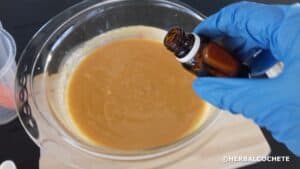
- Assemble everything: ingredients, equipment, safety equipment. Prepare your workstations. Measure all the ingredients. Don’t start the recipe without having everything ready!
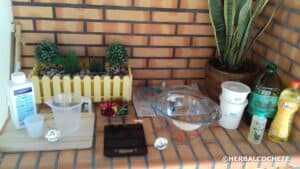
- NOTE: The mica, or soap dye, as well as the essential oil, are optional ingredients. The idea is to turn this coconut soap into a lavender one. You can choose other colors. You can choose other essential oils like litsea cubeba, tea tree or peppermint. Or you can skip the scent and dye entirely for a totally natural coconut soap.
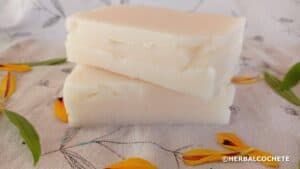
- Add 0,5-1 tsp of coconut oil into to a small cup, add the dye and stir well to avoid lumps. You can add 1/2 teaspoon for a stronger tone and 1/4 teaspoon for a soft tone. The recipe in the video used 1/2 teaspoon.

Heat the Oils
- Melt the coconut oil up to 40ºC – 104ºF
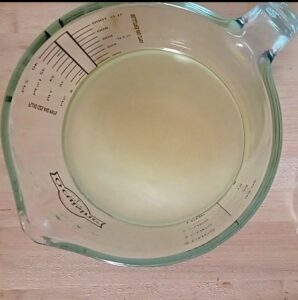
Prepare the Lye Water
- Make the lye solution according to How To Make Lye Water. Mix it until the vapors start to dissipate. Strain it to catch any undissolved lye crystals.
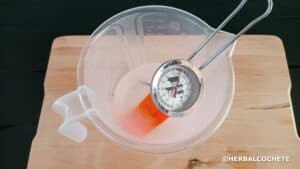
Make the Soap Batter
- Use as a target temperature 35ºC for the oil-solution mixture. If necessary heat the coconut oil a little.
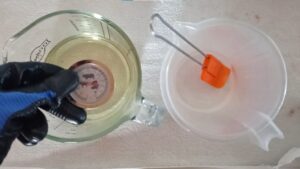
- Pour the lye water into the oils. Starting stick blending.
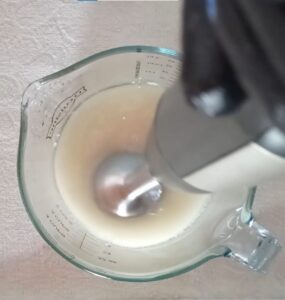
- Now add the oily dye mixture to the soap batter and stir well.
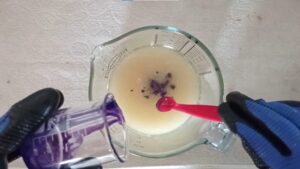
- Reach trace with the immersion blender.
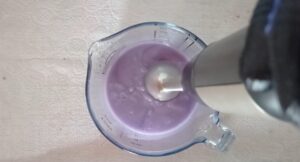
- Add the extract and essential oil (s) after trace. As coconut oil is a hard oil, use a spoon and avoid the stick blender, or the soap batter might seize. Pour the batter into the molds as soon as possible.
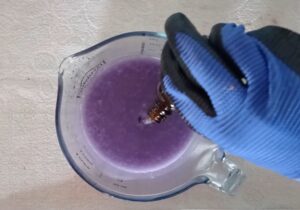
Molding and Curing
- Pour the soap into the molds using a pitcher. Sprinkle with alcohol or witch hazel, to avoid soda ash. Let it set for 12 to 18 hours. You can use pre-heated oven for gel phase.
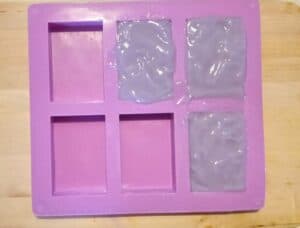
- Unmold and let the bars cure for 4 to 6 weeks. See How To Cure Soap.

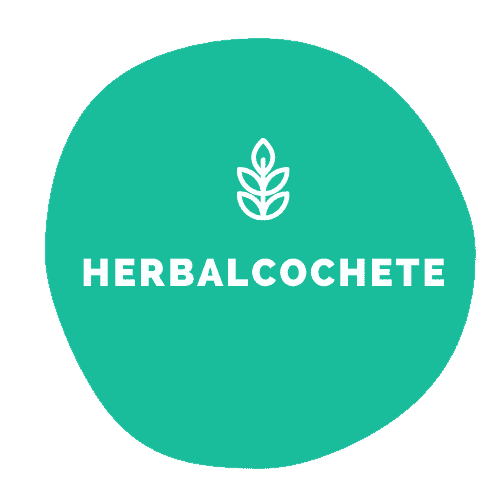
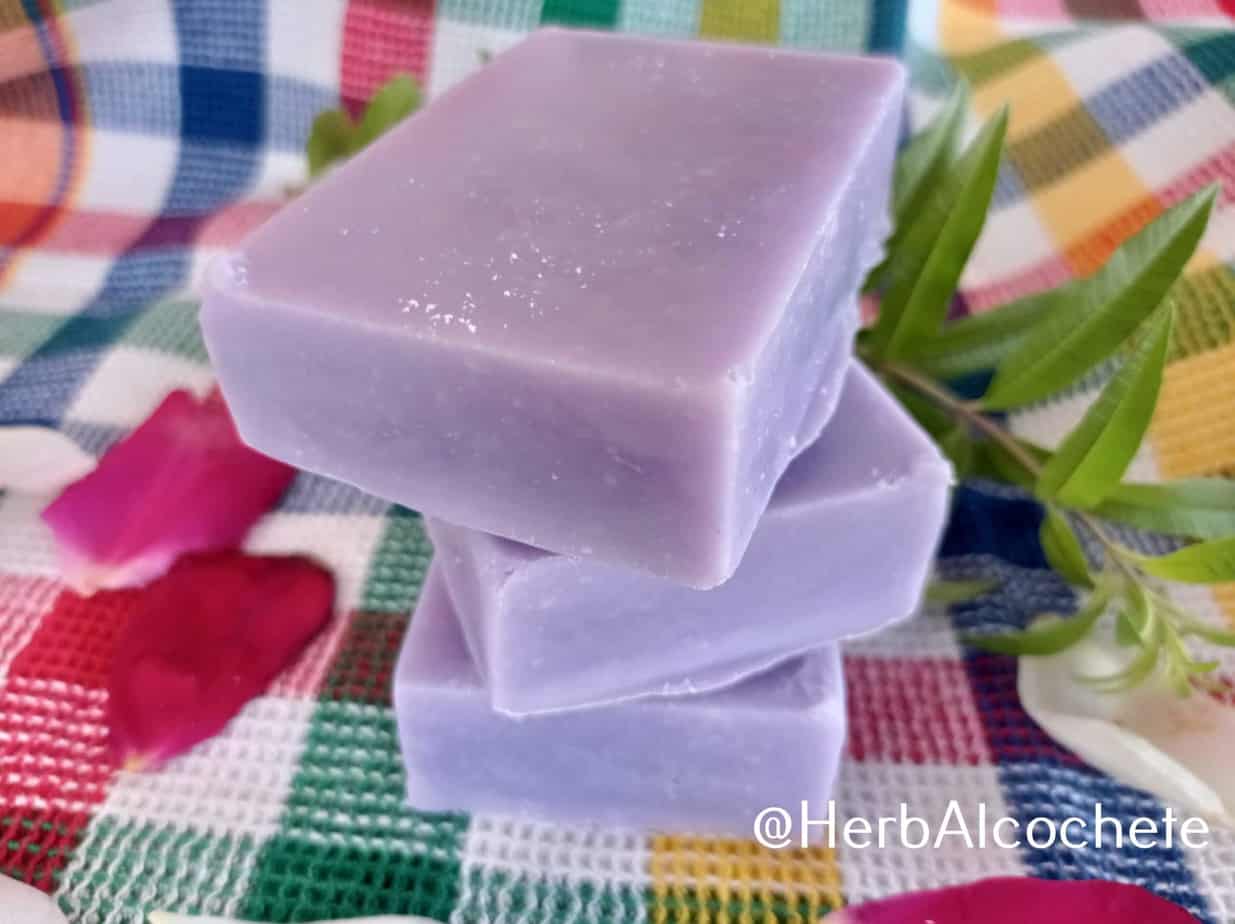

Hello!
I did not understand why coconut oil dried out my hair and skin when I used it in oil form! But I know why now, after reading this article! I wrote that because I love using products with coconut oil and I think this homemade coconut can be an awesome alternative!
I appreciate your knowledge and that you share it with us!
keep Being AMAZING w
Hello Brendaliz, thanks for your comment. Yes, coconut oil can feel a bit “drying”. Personally, I’ve used pure coconut oil, and I never felt my skin or hair “dry”, but it can be due to skin type. You can try the coconut oil soap, but I’d advise you to wash your hands first to see if the soap is also drying on your skin. Best thing will be to try one of my other recipes with an oil mix, you have great conditioners (olive oil and shea butter) in this one: Rosemary and Eucalyptus Soap Recipe.
Cheers, Sofia
I absolutely love coconut and will definitely be trying out your recipe. It will be my first time making soap, but coconut reminds me of the beach, paradise freedom and so the smell just takes me to that place. Really lovely article, grapefruit oil will give it that extra sweet smell and greek yogurt is super healthy. I’m sold, will you be batch making and selling any online? I
Hello Ashyra, thanks for your comment.
Coconut oil soap, unfortunately, due to the chemical reaction, might not smell like coconut, but it will smell like unscented soap. In this recipe, I suggest to put lavender essential oil so it will smell like lavender 🙂 As for Greek Yogurt, yes, I believe it can be used but that’s an advanced soap recipe which to be honest I haven’t tried yet. In here it’s not mentioned as an ingredient, but as an example for a recycled soap mold (you use the yogurt plastic cup).
Unfortunately, portuguese regulation for cosmetics is crazy and totally discourages small soap makers to run a business, so no I can’t sell them although I’d love to 🙁 I make soap only for myself.
Best Regards,
Sofia
Hello; the training on soap making is one skill that can benefit many of our young people who want to be boss but do not want to work.
Many of them can look at your training here and get an understanding of how easy it can be to develop a skill and turn it into a business. Is Coconut Oil the only soap you make? Do you make hand lotion and Face Cream?
DorcasW
Hello, and thanks for your comment. True, the idea is really to empower people, whether my making natural cosmetics for themselves, or by starting a business. I don’t advise it here in Portugal due overwhelming bureaucracy and expenses, but in other countries, it can be a good idea to start a small business.
Yes, I’ve tried facial and body creams, they are so good I use them also for hands 🙂 as a mega skin conditioner (for very dry hands for example) I use a body balm, it’s made with plant infused oils and it can go a bit beyond moisturizing the skin: it helps regenerate your skin for small skin issues like cuts, burns and rashes.
I do plan to post all those in the future 🙂 soap is just the beginning!
Cheers, Sofia
Hi Sofia, This post is about homemade coconut oil soap but I think it gives me a explanation of why my hair was so dry when I started my natural hair journey. I was using straight coconut oil, I should have been using a mixture. Would you happen to have any suggestions of what to mix coconut oil with as a hair product vs a soap?
Hello CeCemorgan, thanks for your comment 🙂
Not sure I’ve fully understood your question as for the product you’re looking for, but I’ll try to answer:
– For hair this is all a bit trickier, it’s not advised to use soap in our hair as its pH can damage hair. At least that’s what I’ve found out when doing some research about this subject.
– I’ve used coconut oil on my hair as a pre-wash treatment (I put the coconut oil, wait 30 minutes, then I wash my hair normally and then put conditioner) and the hair felt cleaner in the end. For conditioning, it’s probably not the best product. Some women states it’s a miracle mask, but some state it’s very drying, and can even damage your hair (it’s all about hair types in the end). At some point, I don’t think my hair was greatly benefitting from a coconut oil treatment, but I’m not against trying it again.
– I’ve read that jojoba oil or argan oil are the real “miracle” oils for hair conditioning. I suppose you can put them naturally, but I am really not very fond of putting oils on my hair. What I did was to prepare a hair conditioner as per this hair conditioner recipe (this is not an affiliate link, just a recipe I tried and recommend). I’ve added to it to use a rosemary infusion instead of plain water. I love this hair conditioner, it’s more conditioning than even the conditioning hair masks we buy in supermarket. Rosemary is there because is very good for hair treatment, and it stimulates hair growth, proven by science.
– Google is full of homemade natural hair masks/conditioners, if you still wish to use coconut oil. One thing I know is that honey is a fantastic moisturizer and anti-septic. Probably coconut oil and honey will complement nicely for a more conditioning hair treatment 🙂 but I haven’t tried it.
Hope this helps!
Cheers, Sofia
Hello!
Great recipe, only with coconut oil! Definitely for coconut oil lovers.
Thanks for sharing.
Hello and thanks for your comment!
Sofia,
Thank you so much for sharing this recipe – this was my first batch of soap. I believe it was successful, soap came out of the mould quite easily and it looks pretty good too (no bubbles).
It has been curing for a week, but I plan to wait longer of course. I am planning on making my own laundry detergent using one of the bars too.
Thank you once again, very easy recipe to follow and very informative. Please post more! You have truly inspired me.
Maija
Hello Maija, thanks so much for your nice and encouraging comment.
I am so happy that your soap is coming good! Yes, you should let it cure for at least 4 weeks, be patient and you will be rewarded 🙂
As for laundry detergent, I do plan to post a couple of laundry detergent recipes. This soap is formulated for skin, it’s soft and it has some free coconut oil to moisturize skin. This free oil is not very welcome to wash clothing in the long term – it’s ok to use it for some weeks, but I don’t advise it forever. If you’re using this soap on your washing machine, make sure to use a harsher detergent every now and then to clean the soap remnants, from both clothing and the washing machine itself.
Enjoy your soaps!!
Cheers,
Sofia
Interesting thanks for your post.